-
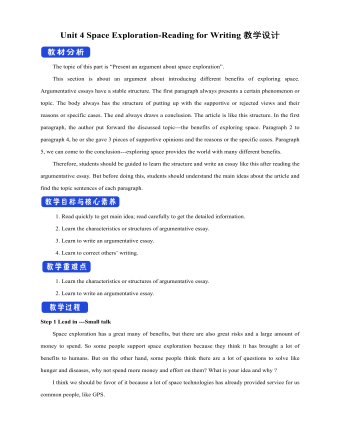
新人教版高中英语必修3Unit 4 Space Exploration-Reading for Writing教学设计二
⑦在我看来, 探索太空是值得的。As far as I am concerned, it is worthwhile to explore the space.Step 10 Writing---draftRecently, students in our class have had heated a discussion on whether space is worth exploring. Students hold different ideas about it.30% of us think space exploration is not worthwhile. They think space is too far away from us and our daily life and is a waste of money. And the money spent on space exploration can be used to solve the earth’s problems such as starvation and pollution.On the other hand,70% think space is worth exploring because we have benefited a lot from it,such as using satellites for communication and weather forecast. What’s more,with further space research,we may solve the population problem by moving to other planets one day. Also,space research will enable us to find new sources to solve the problem of energy shortages on the earth.As far as I am concerned, it is worthwhile to explore the space. Not only can it promote the development of society but also enrich our life. Step 11 Pair workExchange drafts with a partner. Use this checklist to help your partner revise his/her draft.1.Does the writer explain why he/she changed/wanted to change?2.Does the writer tell how the changes have improved or will improve his/her life?3.Is the text well-organised?4.Does the writer use words and expressions to show similarities and differences?5.Are there any grammar or spelling errors?6.Does the writer use correct punctuation?
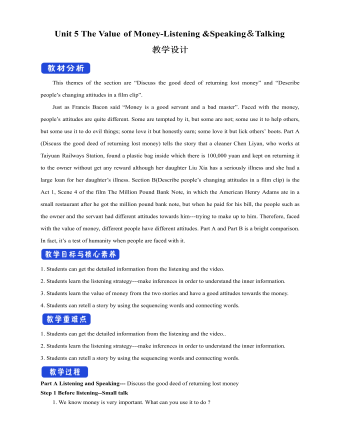
新人教版高中英语必修3Unit 5 The Value of Money-Listening &Speaking&Talking教学设计
4. A:We’d like to have someone to say a word at the beginning to welcome the group.B:↙Who?A:We thought that you or Dr.Johnson might do it.B用降调说Who,其意思是问,对方想让谁在开场时致欢迎词。Step 6 Pronunciation---Practice1. Listen to the short conversation and mark the intonation with ↗, ↙ or ↙, ↗. Then discuss with a partner what they intend to convey by using different intonation.Owner: You know what ?↗ It’s a million-pound bank note↙.Waiter 1: Really ?↗(question)Waiter 2: Really !↙(unbelievable and surprised)Waiter 3: Really ?!↙↗(first question then surprised)2. Listen to the conversations. Underline the parts that are stressed and mark the intonation. Then talk about the implied meanings of the responses with different intonations. Listen again and repeat.1) Henry: It’s a nice suit.Owner: Oh, it’s perfect!↙(The intonation means it is very suitable for Henry.)2) Henry: Well, that’s very kind of you.Owner: Kind, sir ?↗(what you said is not right) No, it’s kind of you. You must come whenever you want and have whatever you like. Just having you sit here is a great honour !!↙(welcome you to come again)3)Henry:Well, to be honest, I have none. Oliver:(happily) What luck!(excited) Brother↗, what luck!↙(It means “Didn’t you hear it?”)Henry: Well, it may seem lucky to you but not to me!↗(angry) If this is your idea of some kind of joke, I don’t think it’s very funny. Now if you’ll excuse me, I ought to be on my way.↙(If so, I would leave.)Roderick: Please don’t go↙...(hope Henry can wait for a moment)Part B Viewing and Talking---Describe people’s changing attitudes in a film clipStep 1 Before-listening---Tell the filmYou are going to watch part of the film The Million Pound Bank Note. Look at these photos and guess what happens in the film.
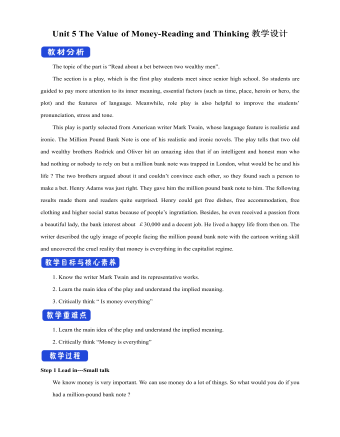
新人教版高中英语必修3Unit 5 The Value of Money-Reading and Thinking教学设计一
Everybody wants to get wealth.In today’s material world,making money or becoming wealthy symbolizes a person’s success and capability. Many people just make every effort, pay any price to attain greater wealth. With money,they can buy nice, large apartments in nice neighborhood. With money they can own luxurious cars. Wealth seems to bring all happiness in life.But is wealth the only road to happiness? Not really. There are many things in the world, which are beyond the means of money, such as friendship, love, health and knowledge. People are so preoccupied with struggling for money that they have no time or would not take the time to form or maintain friendship. What happiness can they feel living as lonely miserable creatures without love or friends in the world even if they accumulate tremendous wealth?In my opinion, people can’t do anything without money, but money is not everything. What money will bring you depends on your personal belief and goal in life. If you are kind enough to help others, especially the poor, money is a good thing to you. With it, you can do much more for the benefit of people and your country, and it will add to your own happiness. If you want money just for your own needs, you’ll never be satisfied or happy. In a word,you should have money spent for more people. Only then can money be the source of your happiness.Step 8 Homework4 students in a group, one acts Roderick, one Oliver, one servant and the fourth one acts Henry Adams, then listen to the tape, pay more attention to the difference between American English and British English in pronunciation, stress, tone.

新人教版高中英语选修2Unit 4 Journey Across a Vast Land教学设计
当孩子们由父母陪同时,他们才被允许进入这个运动场。3.过去分词(短语)作状语时的几种特殊情况(1)过去分词(短语)在句中作时间、条件、原因、让步状语时,相当于对应的时间、条件、原因及让步状语从句。Seen from the top of the mountain (=When it is seen from the top of the mountain), the whole town looks more beautiful.从山顶上看,整个城市看起来更美了。Given ten more minutes (=If we are given ten more minutes), we will finish the work perfectly.如果多给十分钟,我们会完美地完成这项工作。Greatly touched by his words (=Because she was greatly touched by his words), she was full of tears.由于被他的话深深地感动,她满眼泪花。Warned of the storm (=Though they were warned of the storm), the farmers were still working on the farm.尽管被警告了风暴的到来,但农民们仍在农场干活。(2)过去分词(短语)在句中作伴随、方式等状语时,可改为句子的并列谓语或改为并列分句。The teacher came into the room, followed by two students (=and was followed by two students).后面跟着两个学生,老师走进了房间。He spent the whole afternoon, accompanied by his mom(=and was accompanied by his mom).他由母亲陪着度过了一整个下午。

新人教版高中英语选修2Unit 1 Science and Scientists-Reading and thinking教学设计
Step 5: After learning the text, discuss with your peers about the following questions:1.John Snow believed Idea 2 was right. How did he finally prove it?2. Do you think John Snow would have solved this problem without the map?3. Cholera is a 19th century disease. What disease do you think is similar to cholera today?SARS and Covid-19 because they are both deadly and fatally infectious, have an unknown cause and need serious public health care to solve them urgently.keys:1. John Snow finally proved his idea because he found an outbreak that was clearly related to cholera, collected information and was able to tie cases outside the area to the polluted water.2. No. The map helped John Snow organize his ideas. He was able to identify those households that had had many deaths and check their water-drinking habits. He identified those houses that had had no deaths and surveyed their drinking habits. The evidence clearly pointed to the polluted water being the cause.3. SARS and Covid-19 because they are both deadly and fatally infectious, have an unknown cause and need serious public health care to solve them urgently.Step 6: Consolidate what you have learned by filling in the blanks:John Snow was a well-known _1___ in London in the _2__ century. He wanted to find the _3_____ of cholera in order to help people ___4_____ it. In 1854 when a cholera __5__ London, he began to gather information. He ___6__ on a map ___7___ all the dead people had lived and he found that many people who had ___8____ (drink) the dirty water from the __9____ died. So he decided that the polluted water ___10____ cholera. He suggested that the ___11__ of all water supplies should be _12______ and new methods of dealing with ____13___ water be found. Finally, “King Cholera” was __14_____.Keys: 1. doctor 2. 19th 3.cause 4.infected with 5.hit 6.marked 7.where 8.drunk 9.pump 10.carried 11.source 12.examined 13.polluted 14.defeatedHomework: Retell the text after class and preview its language points

新人教版高中英语选修2Unit 2 Bridging Cultures-Discovering useful structures教学设计
The grammar of this unit is designed to review noun clauses. Sentences that use nouns in a sentence are called noun clauses. Nominal clauses can act as subject, object, predicate, appositive and other components in compound sentences. According to the above-mentioned different grammatical functions, nominal clauses are divided into subject clause, object clause, predicate clause and appositive clause. In this unit, we will review the three kinds of nominal clauses. Appositive clauses are not required to be mastered in the optional compulsory stage, so they are not involved.1. Guide the students to judge the compound sentences and determine the composition of the clauses in the sentence.2. Instruct students to try to learn grammar by generalizing grammar rules, controlling written practice, and semi-open oral output.3. Inspire the students to systematize the function and usage of noun clause1.Instruct students to try to learn grammar by generalizing grammar rules, controlling written practice, and semi-open oral output.2.Inspire the students to systematize the function and usage of noun clauseStep1: The teacher ask studetns to find out more nominal clauses from the reading passage and udnerline the nominal clauses.

新人教版高中英语选修2Unit 3 Food and Culture-Reading and thinking教学设计
The discourse explores the link between food and culture from a foreign’s perspective and it records some authentic Chinese food and illustrates the cultural meaning, gerography features and historic tradition that the food reflects. It is aimed to lead students to understand and think about the connection between food and culture. While teaching, the teacher should instruct students to find out the writing order and the writer’s experieces and feelings towards Chinese food and culture.1.Guide the students to read the text, sort out the information and dig out the topic.2.Understand the cultural connotation, regional characteristics and historical tradition of Chinese cuisine3.Understand and explore the relationship between food and people's personality4.Guide the students to use the cohesive words in the text5.Lead students to accurately grasp the real meaning of the information and improve the overall understanding ability by understanding the implied meaning behind the text.1. Enable the Ss to understand the structure and the writing style of the passage well.2. Lead the Ss to understand and think further about the connection between food and geography and local character traits.Step1: Prediction before reading. Before you read, look at the title, and the picture. What do you think this article is about?keys:It is about various culture and cuisine about a place or some countries.

人教版高中地理选修3第五章第一节设计旅游活动教案
点拨:旅游地旅游资源的特色不同,可以安排的旅游活动是不一样的,直接影响对旅游者的吸引力。因此,出游前首先就需要收集旅游地旅游资源的类型、主要游览景区、景点的特色等情况。旅游地的时空可达性直接关系到旅游者从出发地到旅游地,然后再返回出发地的费用和时间。一般来说,居住地与旅游地之间的空间距离过大,会使旅行的时间过长、旅行费用过高,经济距离增加,相应地降低了旅游者的出游能力。而居住地与旅游地相距遥远,也意味着两地之间巨大的环境差异,这会增加对游客的吸引力。旅游服务设施和条件,如旅游交通方式及工具、旅游住宿条件、旅游餐饮的种类和标准、导游服务、旅行费用等信息也都在一定程度上影响着游客的选择。图5.3西藏布达拉宫和图5.4云南香格里拉两幅图片显示了西藏布达拉宫、云南香格里拉与众不同的优美景观,吸引了众多的游客前来观光旅游,成为近年来国内旅游的热点。
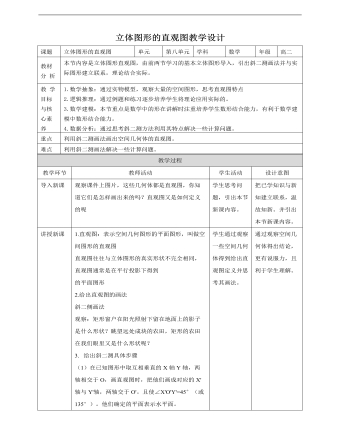
人教A版高中数学必修二立体图形直观图教学设计
1.直观图:表示空间几何图形的平面图形,叫做空间图形的直观图直观图往往与立体图形的真实形状不完全相同,直观图通常是在平行投影下得到的平面图形2.给出直观图的画法斜二侧画法观察:矩形窗户在阳光照射下留在地面上的影子是什么形状?眺望远处成块的农田,矩形的农田在我们眼里又是什么形状呢?3. 给出斜二测具体步骤(1)在已知图形中取互相垂直的X轴Y轴,两轴相交于O,画直观图时,把他们画成对应的X'轴与Y'轴,两轴交于O'。且使∠X'O'Y'=45°(或135°)。他们确定的平面表示水平面。(2)已知图形中平行于X轴或y轴的线段,在直观图中分别画成平行于X'轴或y'轴的线段。(3)已知图形中平行于X轴的线段,在直观图中保持原长度不变,平行于Y轴的线段,在直观图中长度为原来一半。4.对斜二测方法进行举例:对于平面多边形,我们常用斜二测画法画出他们的直观图。如图 A'B'C'D'就是利用斜二测画出的水平放置的正方形ABCD的直观图。其中横向线段A'B'=AB,C'D'=CD;纵向线段A'D'=1/2AD,B'C'=1/2BC;∠D'A'B'=45°,这与我们的直观观察是一致的。5.例一:用斜二测画法画水平放置的六边形的直观图(1)在六边形ABCDEF中,取AD所在直线为X轴,对称轴MN所在直线为Y轴,两轴交于O',使∠X'oy'=45°(2)以o'为中心,在X'上取A'D'=AD,在y'轴上取M'N'=½MN。以点N为中心,画B'C'平行于X'轴,并且等于BC;再以M'为中心,画E'F'平行于X‘轴并且等于EF。 (3)连接A'B',C'D',E'F',F'A',并擦去辅助线x轴y轴,便获得正六边形ABCDEF水平放置的直观图A'B'C'D'E'F' 6. 平面图形的斜二测画法(1)建两个坐标系,注意斜坐标系夹角为45°或135°;(2)与坐标轴平行或重合的线段保持平行或重合;(3)水平线段等长,竖直线段减半;(4)整理.简言之:“横不变,竖减半,平行、重合不改变。”
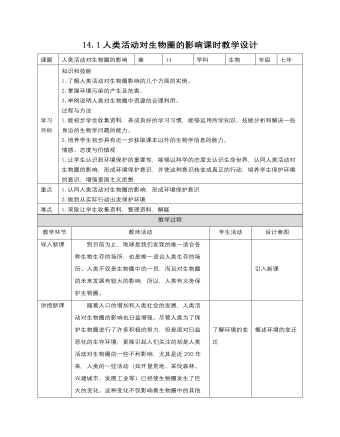
初中生物北师大版七年级下册《第14章第1节人类活动对生物圈的影响》教案
知识和技能 1.了解人类活动对生物圈影响的几个方面的实例。 2.掌握环境污染的产生及危害。 3.举例说明人类对生物圈中资源的合理利用。 过程与方法 1.能初步学会收集资料,养成良好的学习习惯,能够运用所学知识、技能分析和解决一些身边的生物学问题的能力。 2.培养学生初步具有近一步获取课本以外的生物学信息的能力。 情感、态度与价值观 1.让学生认识到环境保护的重要性,能够以科学的态度去认识生命世界,认同人类活动对生物圈的影响,形成环境保护意识,并使这种意识转变成真正的行动,培养学生保护环境的意识,增强爱国主义思想1.认同人类活动对生物圈的影响,形成环境保护意识 2.做到从实际行动出发保护环境1.采取让学生收集资料,整理资料,解疑
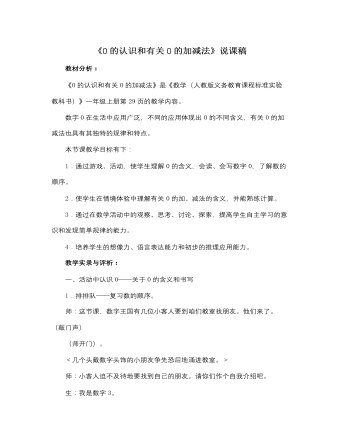
人教版新课标小学数学一年级上册0的认识和有关0的加减法 说课稿
《0的认识和有关0的加减法》是《数学(人教版义务教育课程标准实验教科书)》一年级上册第29页的教学内容。数字0在生活中应用广泛,不同的应用体现出0的不同含义,有关0的加减法也具有其独特的规律和特点。本节课教学目标有下:1.通过游戏、活动,使学生理解0的含义,会读、会写数字0,了解数的顺序。2.使学生在情境体验中理解有关0的加、减法的含义,并能熟练计算。3.通过在数学活动中的观察、思考、讨论、探索,提高学生自主学习的意识和发现简单规律的能力。4.培养学生的想像力、语言表达能力和初步的推理应用能力。教学实录与评析:一、活动中认识0──关于0的含义和书写1.排排队──复习数的顺序。师:这节课,数字王国有几位小客人要到咱们教室找朋友。他们来了。(敲门声)
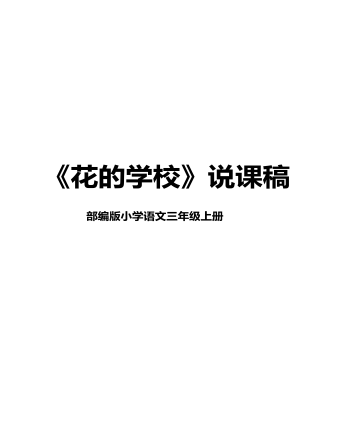
部编版语文三年级上册《花的学校》说课稿
二、说教材这是一篇非常优美的文章,作者以清新流畅的笔触,勾画出甜美纯净的儿童世界。顽强活泼而且具有丰富细腻想象力的孩子,在看到六月里雷电交作、风雨交加之后青草地上冒出的花儿时,就在自己想像的天空里自由驰骋起来。他把未冒出地面得花儿想象成地下学校上学的孩子们,在墙角旮旯冒出来的零星小花是犯错误被罚站的小孩儿,大雨来时,花儿们便衣着鲜艳地冲出学校度假了,而花儿们这么急切地生长是因为要回家找它们的妈妈。作者巧妙地从孩子的眼中叙出花儿们的活泼、可爱、美丽、向上,充满了儿童情趣。教学中我注重学生的朗读指导,读出花孩子的天真烂漫、活泼可爱、勇敢坚强、活泼向上、童真童趣。同时也注重培养学生的问题意识。
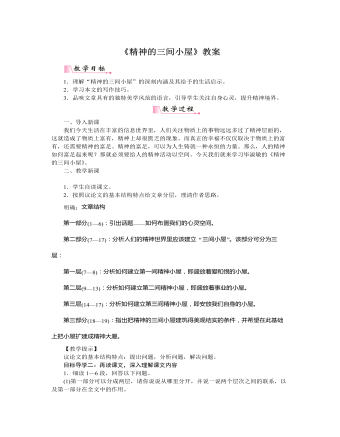
部编版语文九年级上册《精神的三间小屋》教案
(4)写第三间小屋时作者为什么说“在我们的小屋里,住着所有我们认识的人,唯独没有我们自己”?明确:这是一个信息高度发达的社会,我们能从不同渠道接受各种纷繁复杂的信息,渐渐,有的人就被这个信息社会所同化了,常常随波逐流,用他人的观点来肯定事物的价值,常常以为众人所追求的就是他们自己想要的。于是别人的思想、外在的信息代替了他们自己的思想,使自己成为缺乏思想和思考的人,所以说“唯独没有我们自己”。(5)你认为在第三间精神小屋中应该怎样“安放我们自身”呢?明确:安放自身需要思考,拥有独立的思想。(6)请你结合日常生活,说说你是否尝试过如此构建“精神的三间小屋”。【教学提示】引导学生在对“精神的三间小屋”的理解基础上来审视生活,从而达到反思生活,审视自我精神世界,建构自我精神世界的目的。
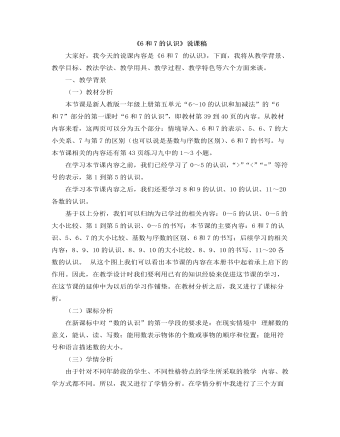
小学数学人教版一年级上册《6和7的认识》说课稿
大家好,我今天的说课内容是《6和7 的认识》,下面,我将从教学背景、教学目标、教法学法、教学用具、教学过程、教学特色等六个方面来谈。一、教学背景(一)教材分析本节课是新人教版一年级上册第五单元“6~10的认识和加减法”的“6和7”部分的第一课时“6和7的认识”,即教材第39到40页的内容。从教材内容来看,这两页可以分为五个部分:情境导入、6和7的表示、5、6、7的大小关系、7与第7的区别(也可以说是基数与序数的区别)、6和7的书写。与本节课相关的内容还有第43页练习九中的1~3小题。在学习本节课内容之前,我们已经学习了0~5的认识,“>”“<”“=”等符号的表示,第1到第5的认识。在学习本节课内容之后,我们还要学习8和9的认识、10的认识、11~20各数的认识。
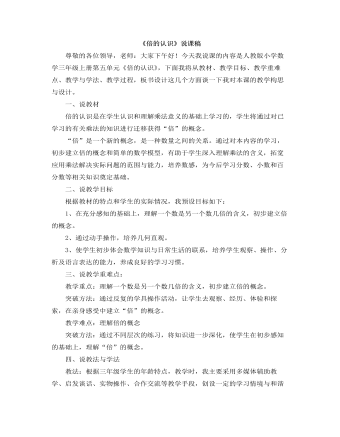
小学数学人教版三年级上册《倍的认识》说课稿
一、说教材倍的认识是在学生认识和理解乘法意义的基础上学习的,学生将通过对已学习的有关乘法的知识进行迁移获得“倍”的概念。“倍”是一个新的概念,是一种数量之间的关系。通过对本内容的学习,初步建立倍的概念和简单的数学模型,有助于学生深入理解乘法的含义,拓宽应用乘法解决实际问题的范围与能力,培养数感,为今后学习分数、小数和百分数等相关知识奠定基础。二、说教学目标根据教材的特点和学生的实际情况,我预设目标如下:1、在充分感知的基础上,理解一个数是另一个数几倍的含义,初步建立倍的概念。2、通过动手操作,培养几何直观。3、使学生初步体会数学知识与日常生活的联系,培养学生观察、操作、分析及语言表达的能力,养成良好的学习习惯。三、说教学重难点:教学重点:理解一个数是另一个数几倍的含义,初步建立倍的概念。突破方法:通过反复的学具操作活动,让学生去观察、经历、体验和探索,在亲身感受中建立“倍”的概念。
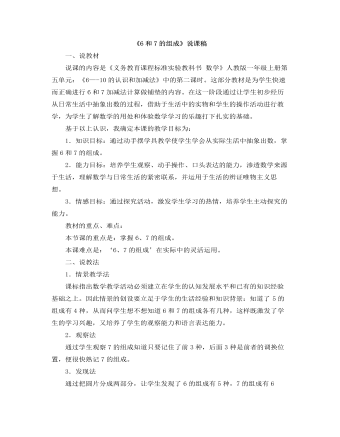
小学数学人教版一年级上册《6和7的组成》说课稿
一、说教材说课的内容是《义务教育课程标准实验教科书 数学》人教版一年级上册第五单元:《6—-10的认识和加减法》中的第二课时。这部分教材是为学生快速而正确进行6和7加减法计算做铺垫的内容。在这一阶段通过让学生初步经历从日常生活中抽象出数的过程,借助于生活中的实物和学生的操作活动进行教学,为学生了解数学的用处和体验数学学习的乐趣打下扎实的基础。基于以上认识,我确定本课的教学目标为:1.知识目标:通过动手摆学具教学使学生学会从实际生活中抽象出数,掌握6和7的组成。2.能力目标:培养学生观察、动手操作、口头表达的能力,渗透数学来源于生活,理解数学与日常生活的紧密联系,并运用于生活的辨证唯物主义思想。3.情感目标:通过探究活动,激发学生学习的热情,培养学生主动探究的能力。教材的重点、难点:本节课的重点是:掌握6、7的组成。本课难点是:‘6、7的组成’在实际中的灵活运用。
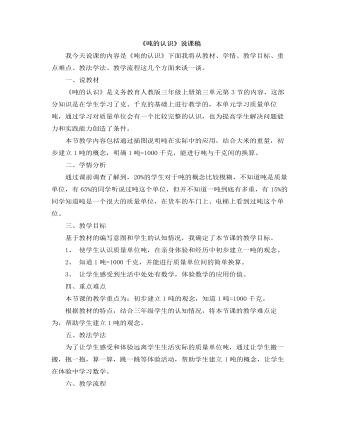
小学数学人教版三年级上册《吨的认识》说课稿
一、说教材《吨的认识》是义务教育人教版三年级上册第三单元第3节的内容,这部分知识是在学生学习了克、千克的基础上进行教学的,本单元学习质量单位吨,通过学习对质量单位会有一个比较完整的认识,也为提高学生解决问题能力和实践能力创造了条件。本节教学内容包括通过插图说明吨在实际中的应用,结合大米的重量,初步建立1吨的概念,明确1吨=1000千克,能进行吨与千克间的换算。二、学情分析通过课前调查了解到,20%的学生对于吨的概念比较模糊,不知道吨是质量单位,有65%的同学听说过吨这个单位,但并不知道一吨到底有多重,有15%的同学知道吨是一个很大的质量单位,在货车的车门上、电梯上看到过吨这个单位。
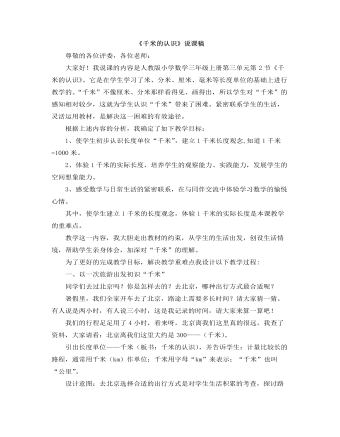
小学数学人教版三年级上册《千米的认识》说课稿
尊敬的各位评委,各位老师:大家好!我说课的内容是人教版小学数学三年级上册第三单元第2节《千米的认识》。它是在学生学习了米、分米、厘米、毫米等长度单位的基础上进行教学的。“千米”不像厘米、分米那样看得见、画得出,所以学生对“千米”的感知相对较少,这就为学生认识“千米”带来了困难。紧密联系学生的生活,灵活运用教材,是解决这一困难的有效途径。根据上述内容的分析,我确定了如下教学目标:1、使学生初步认识长度单位“千米”,建立1千米长度观念,知道1千米=1000米。2、体验1千米的实际长度,培养学生的观察能力、实践能力,发展学生的空间想象能力。3、感受数学与日常生活的紧密联系,在与同伴交流中体验学习数学的愉悦心情。其中,使学生建立1千米的长度观念,体验1千米的实际长度是本课教学的重难点。
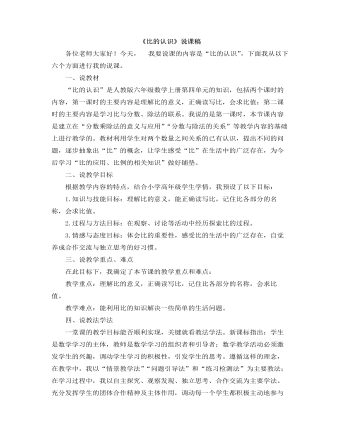
小学数学人教版六年级上册《比的认识》说课稿
五、说教学过程兴趣是学习的动力,问题是思维的核心。为了激发学生的兴趣,发展学生的思维,本节课从学生感兴趣的事物出发,始终以问题为引领,遵循“现实题材→数学问题→数学模型→数学方法→解决问题”的过程来设计教学,引导学生将实际问题抽象成数学模型,并进行探索与应用的过程,使学生逐步学会用数学知识和方法解决生活中的实际问题。根据这样的新课标设计理念,我安排了以下五个教学环节:(一)创设情境,引入比为激发学生的兴趣,我从学生感兴趣的杨利伟叔叔及其事迹出发,设置问题,逐步引入新课。同学们,认识杨利伟叔叔吗?他就是载人飞船“神舟”五号的航天员。2003年10月15日,我国第一艘载人飞船“神舟”五号顺利升空。
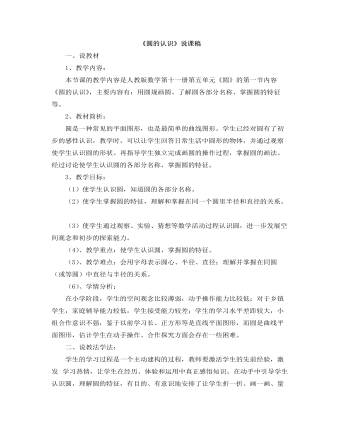
小学数学人教版六年级上册《圆的认识》说课稿
二、说教法学法:学生的学习过程是一个主动建构的过程,教师要激活学生的先前经验,激发 学习热情,让学生在经历、体验和运用中真正感悟知识。在动手中引导学生认识圆,理解圆的特征,有目的、有意识地安排了让学生折一折、画一画、量一量、比一比等动手实践活动,启发学生用眼观察,动脑思考,动口参加讨论,用心去辨析同学们的答案。教学中理应发挥学生的主体作用,淡化教师的主观影响,让学生自己在实践中产生问题意识,自己探究、尝试,修正错误,总结规律,从而主动获取知识。本节课我采用了多媒体教学手段,主要运用操作、探究、讨论、发现等教学方法。学生的学法与教法相对应,让学生主动探索、主动交流、主动提问。通过多媒体的直观演示将演示、观察、操作、思维与语言表达结合在一起,使学生对圆有一个形象的感知。同时作用于学生的感官,调动学生的学习积极性,给学生充分的时间和机会让他们主动参与获取知识的过程,培养学生自主学习的意识与创新意识。